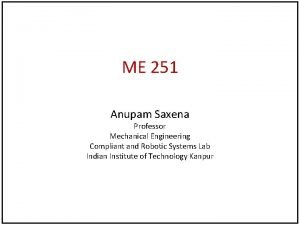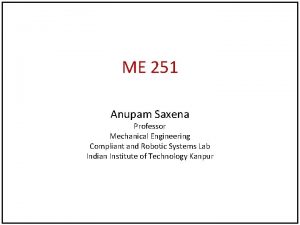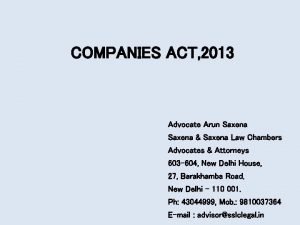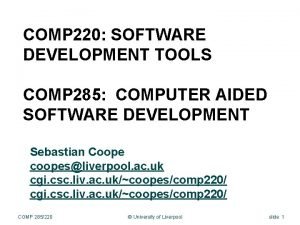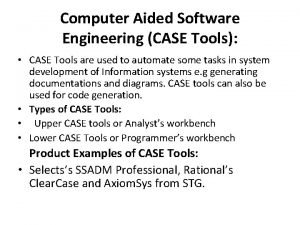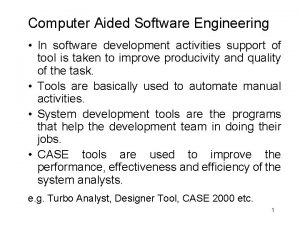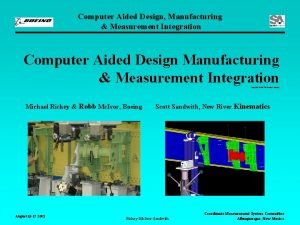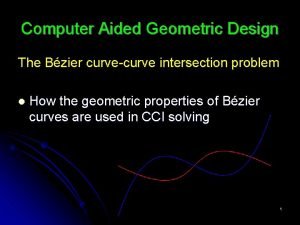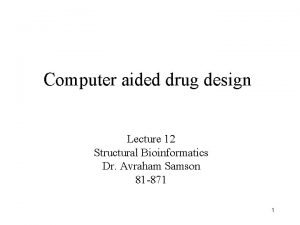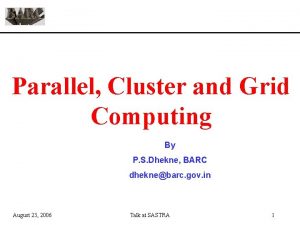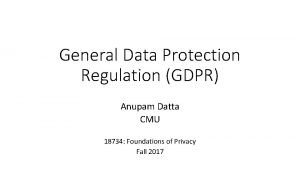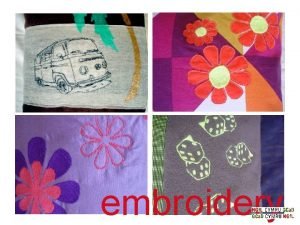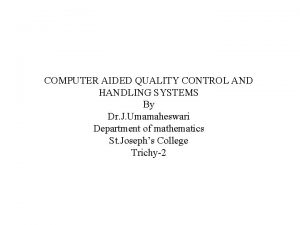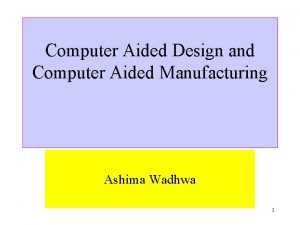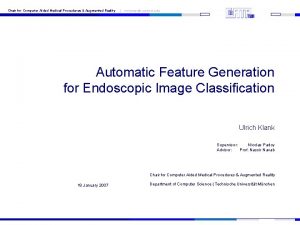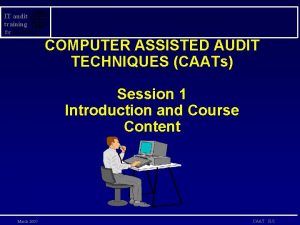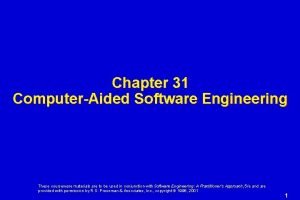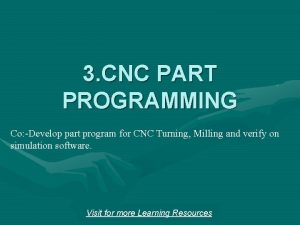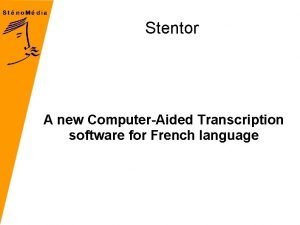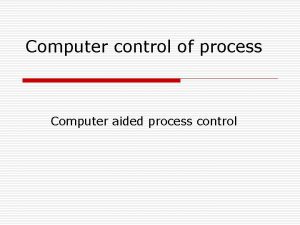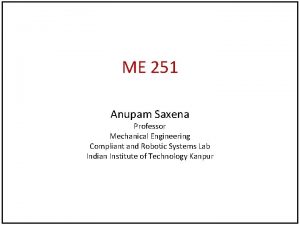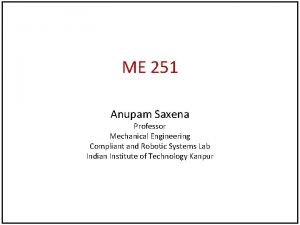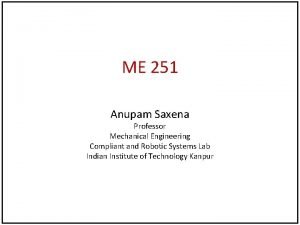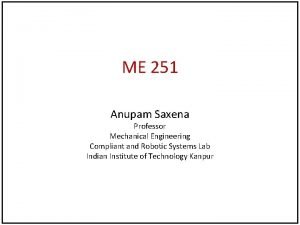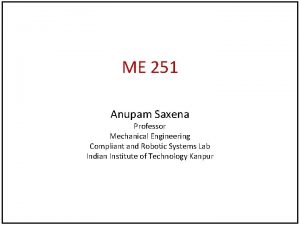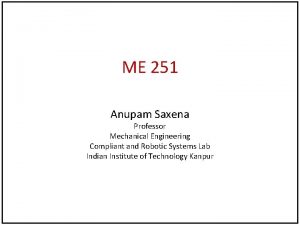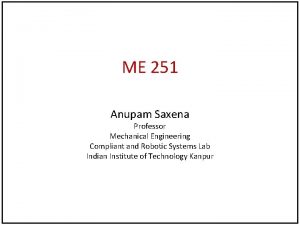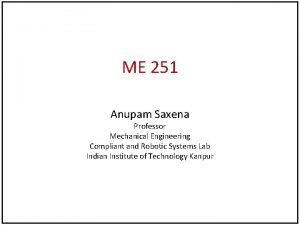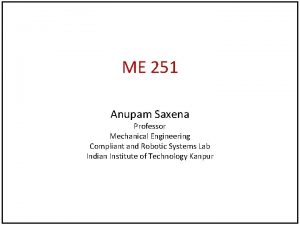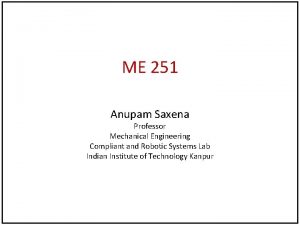Computer Aided Engineering Design Anupam Saxena Associate Professor




























- Slides: 28

Computer Aided Engineering Design Anupam Saxena Associate Professor Indian Institute of Technology KANPUR 208016

Recollection! Geometric/PARAMETRIC Modeling of Solid Modeling of Represent Curves Surfaces ation, (Patches) Differentia Perception Differentia l of Solids l Geometry Topology Ferguson Tensor and Solids Segments Product Solid Modeling 1 -2 Transform Bezier Segments 1 -2 Boundary Interpolati ng B-spline curves 1 -5 Composite NURBS ations and Projection s 1 -2

Geometric/PARAMETRIC Modeling of Solid Modeling of Represent Curves Surfaces ation, (Patches) Differentia Perception Differentia l of Solids l Geometry Topology Ferguson Tensor and Solids Segments Product Solid Modeling 1 -2 Transform Bezier Segments 1 -2 Boundary Interpolati ng B-spline curves 1 -5 Composite NURBS ations and Projection s 1 -2 #6 Representation of Solids

Half Spaces - Half-spaces are unbounded geometric entities Geometric/PARAMETRIC Modeling of Solid Modeling of Represent Curves Surfaces ation, (Patches) Differentia Perception Differentia l of Solids l Geometry Topology Ferguson Tensor and Solids Segments Product Solid Modeling 1 -2 Transform Bezier Segments 1 -2 Boundary Interpolati ng B-spline curves 1 -5 Composite NURBS ations and Projection s 1 -2 - they divide the representation space E 3 into two infinite portions - one filled with material while the other empty - Surfaces are half-space boundaries - half-spaces can be treated as directed surfaces the direction vector points towards the material side -

Half spaces: Examples Geometric/PARAMETRIC Modeling of Solid Modeling of Represent Curves Surfaces ation, (Patches) Differentia Perception Differentia l of Solids l Geometry Topology Ferguson Tensor and Solids Segments Product Solid Modeling 1 -2 Transform Bezier Segments 1 -2 Boundary Interpolati ng B-spline curves 1 -5 Composite NURBS ations and Projection s 1 -2 – A half-space H can be defined as a regular point set in E 3 such that – H = {P| P E 3 and f(P) < 0} • f(P) = 0 defines the surface equation – Examples • Planar half-space: • Cylindrical half-space: • Spherical half-space: H = {(x, y, z)| z < 0} H = {(x, y, z)| x 2 + y 2 < R 2} H = {(x, y, z)| x 2 + y 2 + z 2 < R 2} • Conical half-space : H = {(x, y, z)| x 2 + y 2 < tan 2( /2)[z]2} • Toroidal half-space with radii R 1 and R 2: • H = {(x, y, z)| (x 2 + y 2 + z 2 – R 22 – R 12)2 < 4 R 22(R 12 – z 2)}

Solid with half spaces Geometric/PARAMETRIC Modeling of Solid Modeling of Represent Curves Surfaces ation, (Patches) Differentia Perception Differentia l of Solids l Geometry Topology Ferguson Tensor and Solids Segments Product Solid Modeling 1 -2 Transform Bezier Segments 1 -2 Boundary Interpolati ng B-spline curves 1 -5 Composite NURBS ations and Projection s 1 -2 - Complex objects can be modeled as halfspaces combined using set (union, subtraction) operations - Half-spaces acting as bounding patches for solids can be free form surfaces

An L Bracket Example H 4 H 1 Geometric/PARAMETRIC Modeling of Solid Modeling of Represent Curves Surfaces ation, (Patches) Differentia Perception Differentia l of Solids l Geometry Topology Ferguson Tensor and Solids Segments Product Solid Modeling 1 -2 Transform Bezier Segments 1 -2 Boundary Interpolati ng B-spline curves 1 -5 Composite NURBS ations and Projection s 1 -2 H 9 H 7 H 8 H 3 H 5 H 2 H 6

Construction using ½ Spaces H 4 H 1 Geometric/PARAMETRIC Modeling of Solid Modeling of Represent Curves Surfaces ation, (Patches) Differentia Perception Differentia l of Solids l Geometry Topology Ferguson Tensor and Solids Segments Product Solid Modeling 1 -2 Transform Bezier Segments 1 -2 Boundary Interpolati ng B-spline curves 1 -5 Composite NURBS ations and Projection s 1 -2 H 7 H 8 H 9 H 3 H 5 H 2 H 6

Representation scheme Geometric/PARAMETRIC Modeling of Solid Modeling of Represent Curves Surfaces ation, (Patches) Differentia Perception Differentia l of Solids l Geometry Topology Ferguson Tensor and Solids Segments Product Solid Modeling 1 -2 Transform Bezier Segments 1 -2 Boundary Interpolati ng B-spline curves 1 -5 Composite NURBS ations and Projection s 1 -2 (a) be versatile and capable of modeling a generic solid (b) generate valid solids (c) be complete in the sense that every valid representation (solid) produced is unambiguous (d) generate unique solids in that no two different representations should generate the same object (e) have closure implying that permitted transformation operations on valid solids always yield valid solids (f) be compact and efficient in matters of data storage and retrieval.

Two representation schemes Geometric/PARAMETRIC Modeling of Solid Modeling of Represent Curves Surfaces ation, (Patches) Differentia Perception Differentia l of Solids l Geometry Topology Ferguson Tensor and Solids Segments Product Solid Modeling 1 -2 Transform Bezier Segments 1 -2 Boundary Interpolati ng B-spline curves 1 -5 Composite NURBS ations and Projection s 1 -2 – Work well for Polyhedral solids – Can be extended for use with homeomorphic non-polyhedral solids

Wireframe representation • one of the oldest ways to represent solids Geometric/PARAMETRIC Modeling of Solid Modeling of Represent Curves Surfaces ation, (Patches) Differentia Perception Differentia l of Solids l Geometry Topology Ferguson Tensor and Solids Segments Product Solid Modeling 1 -2 Transform Bezier Segments 1 -2 Boundary Interpolati ng B-spline curves 1 -5 Composite NURBS ations and Projection s 1 -2 • representation is essentially through a set of key vertices connected by key edges • both topological and ( information is stored ) geometric • The edges may be straight or curved

Example: Wireframe Tetrahedron Geometric/PARAMETRIC Modeling of Solid Modeling of Represent Curves Surfaces ation, (Patches) Differentia Perception Differentia l of Solids l Geometry Topology Ferguson Tensor and Solids Segments Product Solid Modeling 1 -2 Transform Bezier Segments 1 -2 Boundary Interpolati ng B-spline curves 1 -5 Composite NURBS ations and Projection s 1 -2 4 Edge Number 1 2 3 4 5 6 (5) (4) 3 (3) (6) (2) Vertex 1 1 2 1 1 3 2 Vertex 2 2 3 3 4 4 4 1 (1) 2 z x y Vertex Number x y z 1 0 0 0 2 1 4 0 3 3 2 0 4 1 2 4

Example: Wireframe Block Geometric/PARAMETRIC Modeling of Solid Modeling of Represent Curves Surfaces ation, (Patches) Differentia Perception Differentia l of Solids l Geometry Topology Ferguson Tensor and Solids Segments Product Solid Modeling 1 -2 Transform Bezier Segments 1 -2 Boundary Interpolati ng B-spline curves 1 -5 Composite NURBS ations and Projection s 1 -2 (12) 8 (11) 7 (8) 5 (10) (9) 6 (5) (4) 4 (7) (3) (6) 1 3 (2) (1) 2 Edge table 1 1 2 2 2 3 3 3 4 4 4 1 5 5 1 6 6 2 7 7 3 8 8 4 9 5 6 10 6 7 11 7 8 12 8 5 vertex table 1 0 0 0 2 10 0 0 3 10 10 0 4 0 10 0 5 0 0 10 6 10 0 10 7 10 10 10 8 0 10 10

Advantages and Drawbacks Geometric/PARAMETRIC Modeling of Solid Modeling of Represent Curves Surfaces ation, (Patches) Differentia Perception Differentia l of Solids l Geometry Topology Ferguson Tensor and Solids Segments Product Solid Modeling 1 -2 Transform Bezier Segments 1 -2 Boundary Interpolati ng B-spline curves 1 -5 Composite NURBS ations and Projection s 1 -2 – wireframe models are simple, – they are non-unique and ambiguous • the models do not include the face information.

Ambiguity with wireframe models Geometric/PARAMETRIC Modeling of Solid Modeling of Represent Curves Surfaces ation, (Patches) Differentia Perception Differentia l of Solids l Geometry Topology Ferguson Tensor and Solids Segments Product Solid Modeling 1 -2 Transform Bezier Segments 1 -2 Boundary Interpolati ng B-spline curves 1 -5 Composite NURBS ations and Projection s 1 -2

Boundary Representation scheme Geometric/PARAMETRIC Modeling of Solid Modeling of Represent Curves Surfaces ation, (Patches) Differentia Perception Differentia l of Solids l Geometry Topology Ferguson Tensor and Solids Segments Product Solid Modeling 1 -2 Transform Bezier Segments 1 -2 Boundary Interpolati ng B-spline curves 1 -5 Composite NURBS ations and Projection s 1 -2 – B-rep for short – an extension of wireframe modeling to include the face information – The faces can either be analytical or free form surfaces – B-rep uses the Jordan’s curve theorem on boundary determinism • a closed connected surface determines the interior of a solid – both topological and geometric information is stored

Face orientations with B-rep Geometric/PARAMETRIC Modeling of Solid Modeling of Represent Curves Surfaces ation, (Patches) Differentia Perception Differentia l of Solids l Geometry Topology Ferguson Tensor and Solids Segments Product Solid Modeling 1 -2 Transform Bezier Segments 1 -2 Boundary Interpolati ng B-spline curves 1 -5 Composite NURBS ations and Projection s 1 -2 – Face orientations may be recorded such that a normal to the face points into the solid. – This can be ensured by the clockwise ordering of vertices (right-handed rule) associated with the face – Using normal vectors, one can distinguish the interior of the solid from its exterior

Example: Face orientation Geometric/PARAMETRIC Modeling of Solid Modeling of Represent Curves Surfaces ation, (Patches) Differentia Perception Differentia l of Solids l Geometry Topology Ferguson Tensor and Solids Segments Product Solid Modeling 1 -2 Transform Bezier Segments 1 -2 Boundary Interpolati ng B-spline curves 1 -5 Composite NURBS ations and Projection s 1 -2 Face 1: Face 2: Face 3: Face 4: 4 (5) (4) 3 (3) (6) (2) 1 (1) 2 z x y 1, 4, 2 2, 4, 3 3, 4, 1 2, 3, 1

Winged Edge data structure • Data storage method with B-Rep • Employs only edges to document the connectivity Geometric/PARAMETRIC Modeling of Solid Modeling of Represent Curves Surfaces ation, (Patches) Differentia Perception Differentia l of Solids l Geometry Topology Ferguson Tensor and Solids Segments Product Solid Modeling 1 -2 Transform Bezier Segments 1 -2 Boundary Interpolati ng B-spline curves 1 -5 Composite NURBS ations and Projection s 1 -2 Back face D 4 (5) (6) 4 (6) (5) A (3) (4) 3 B B (3) (2) C 2 1 (1) A 2 (1) (2)

Winged Edge data storage Tetrahedron Back face D 4 Geometric/PARAMETRIC Modeling of Solid Modeling of Represent Curves Surfaces ation, (Patches) Differentia Perception Differentia l of Solids l Geometry Topology Ferguson Tensor and Solids Segments Product Solid Modeling 1 -2 Transform Bezier Segments 1 -2 Boundary Interpolati ng B-spline curves 1 -5 Composite NURBS ations and Projection s 1 -2 (6) 4 (6) (5) A (3) (4) A 3 B B (3) (2) C 2 1 (1) Edge (5) (1) 2 Vertices Clockwise Traverse on Face 1 Faces (2) Clockwise traverse on Face 2 Name Start End Face 1 Face 2 Preceding Edge Suceeding Edge (3) 2 4 A B (5) (1) (2) (6) (1) 1 2 A C (3) (5) (4) (2) 2 3 B C (6) (3) (1) (4) 1 3 D C (5) (6) (2) (1) (5) 1 4 D A (6) (4) (1) (3) (6) 3 4 B D (3) (2) (4) (5)

Additional tables with Winged Edge Structure Geometric/PARAMETRIC Modeling of Solid Modeling of Represent Curves Surfaces ation, (Patches) Differentia Perception Differentia l of Solids l Geometry Topology Ferguson Tensor and Solids Segments Product Solid Modeling 1 -2 Transform Bezier Segments 1 -2 Boundary Interpolati ng B-spline curves 1 -5 Composite NURBS ations and Projection s 1 -2 face table vertex table Face Edge A (1) B (2) C (4) D Vertex Edge 1 (1) 2 (2) 3 (3) 4 (6) (5) These are non-unique tables

Internal loops in Winged Edge Structure Geometric/PARAMETRIC Modeling of Solid Modeling of Represent Curves Surfaces ation, (Patches) Differentia Perception Differentia l of Solids l Geometry Topology Ferguson Tensor and Solids Segments Product Solid Modeling 1 -2 Transform Bezier Segments 1 -2 Boundary Interpolati ng B-spline curves 1 -5 Composite NURBS ations and Projection s 1 -2 – When internal loops present (a) Assign them counterclockwise orientation OR/AND (b) Connect the internal loop with the external one using auxiliary edges – Effectively, only one loop will be present – An Auxiliary edge will have the same face on the left and right

Euler-Poincaré formula • How do we know a polyhedral solid is a valid solid? Geometric/PARAMETRIC Modeling of Solid Modeling of Represent Curves Surfaces ation, (Patches) Differentia Perception Differentia l of Solids l Geometry Topology Ferguson Tensor and Solids Segments Product Solid Modeling 1 -2 Transform Bezier Segments 1 -2 Boundary Interpolati ng B-spline curves 1 -5 Composite NURBS ations and Projection s 1 -2 • V – E + F – (L – F) – 2(S – G) = 0 * • • Extended to include pot and through holes V as number of vertices, E as the number of edges, F as the number of faces, G as the number of holes (or genus) penetrating the solid, S as the number of shells and L as the total number of outer and inner loops – a shell is an internal void of a solid bounded by a closed connected surface that can have its own genus value * For a valid solid, this is true. Converse, however, is NOT TRUE

Euler-Poincaré formula • Example 1: Geometric/PARAMETRIC Modeling of Solid Modeling of Represent Curves Surfaces ation, (Patches) Differentia Perception Differentia l of Solids l Geometry Topology Ferguson Tensor and Solids Segments Product Solid Modeling 1 -2 Transform Bezier Segments 1 -2 Boundary Interpolati ng B-spline curves 1 -5 Composite NURBS ations and Projection s 1 -2 V=8 E = 12 F=6 L=6 S=1 G=0 V – E + F – (L – F) – 2(S – G) 8 – 12 + 6 – (6 – 6) – 2(1 – 0) = 0

Euler-Poincaré formula • Example 2: Geometric/PARAMETRIC Modeling of Solid Modeling of Represent Curves Surfaces ation, (Patches) Differentia Perception Differentia l of Solids l Geometry Topology Ferguson Tensor and Solids Segments Product Solid Modeling 1 -2 Transform Bezier Segments 1 -2 Boundary Interpolati ng B-spline curves 1 -5 Composite NURBS ations and Projection s 1 -2 V = 16 E = 24 F = 11 L = 12 S=1 G=0 V – E + F – (L – F) – 2(S – G) 16 – 24 + 11 – (12 – 11) – 2(1 – 0) = 0

Euler-Poincaré formula • Example 3: Geometric/PARAMETRIC Modeling of Solid Modeling of Represent Curves Surfaces ation, (Patches) Differentia Perception Differentia l of Solids l Geometry Topology Ferguson Tensor and Solids Segments Product Solid Modeling 1 -2 Transform Bezier Segments 1 -2 Boundary Interpolati ng B-spline curves 1 -5 Composite NURBS ations and Projection s 1 -2 V = 16 E = 24 F = 10 L = 12 S=1 G=1 V – E + F – (L – F) – 2(S – G) 16 – 24 + 10 – (12 – 10) – 2(1 – 1) = 0

Euler-Poincaré formula • Example 4: Geometric/PARAMETRIC Modeling of Solid Modeling of Represent Curves Surfaces ation, (Patches) Differentia Perception Differentia l of Solids l Geometry Topology Ferguson Tensor and Solids Segments Product Solid Modeling 1 -2 Transform Bezier Segments 1 -2 Boundary Interpolati ng B-spline curves 1 -5 Composite NURBS ations and Projection s 1 -2 V = 24 E = 36 F = 16 L = 18 S=2 G=1 V – E + F – (L – F) – 2(S – G) 24 – 36 + 16 – (18 – 16) – 2(2 – 1) = 0

Euler-Poincaré formula • Example 5: Geometric/PARAMETRIC Modeling of Solid Modeling of Represent Curves Surfaces ation, (Patches) Differentia Perception Differentia l of Solids l Geometry Topology Ferguson Tensor and Solids Segments Product Solid Modeling 1 -2 Transform Bezier Segments 1 -2 Boundary Interpolati ng B-spline curves 1 -5 Composite NURBS ations and Projection s 1 -2 V = 10 E = 15 F=7 L=7 S=1 G=0 This is NOT a valid solid One face is dangling V – E + F – (L – F) – 2(S – G) 10 – 15 + 7 – (7 – 7) – 2(1 – 0) = 0
 Euler-poincaré formula
Euler-poincaré formula Anupam saxena
Anupam saxena Anupam saxena
Anupam saxena Saxena and saxena law chambers
Saxena and saxena law chambers Promotion from associate professor to professor
Promotion from associate professor to professor Toolscomp
Toolscomp Lower case tools examples
Lower case tools examples Computer aided software testing
Computer aided software testing Computer-aided design integrator
Computer-aided design integrator Computer-aided drug design lecture notes
Computer-aided drug design lecture notes Computer aided geometric design
Computer aided geometric design Cadd drug design
Cadd drug design Anupam series supercomputer
Anupam series supercomputer 18734 cmu
18734 cmu Sep certification
Sep certification Computer design embroidery
Computer design embroidery Catt program
Catt program Computer aided quality
Computer aided quality Computer aided manufacturing definition
Computer aided manufacturing definition Computer aided medical procedures
Computer aided medical procedures Computer aided medical procedures
Computer aided medical procedures Caat course
Caat course Computer aided software testing
Computer aided software testing Tab sequential format
Tab sequential format Computer aided hazard analysis
Computer aided hazard analysis Benefits of capp
Benefits of capp What is computer assisted language learning (call)
What is computer assisted language learning (call) Computer aided transcription software
Computer aided transcription software Computer aided process control
Computer aided process control

